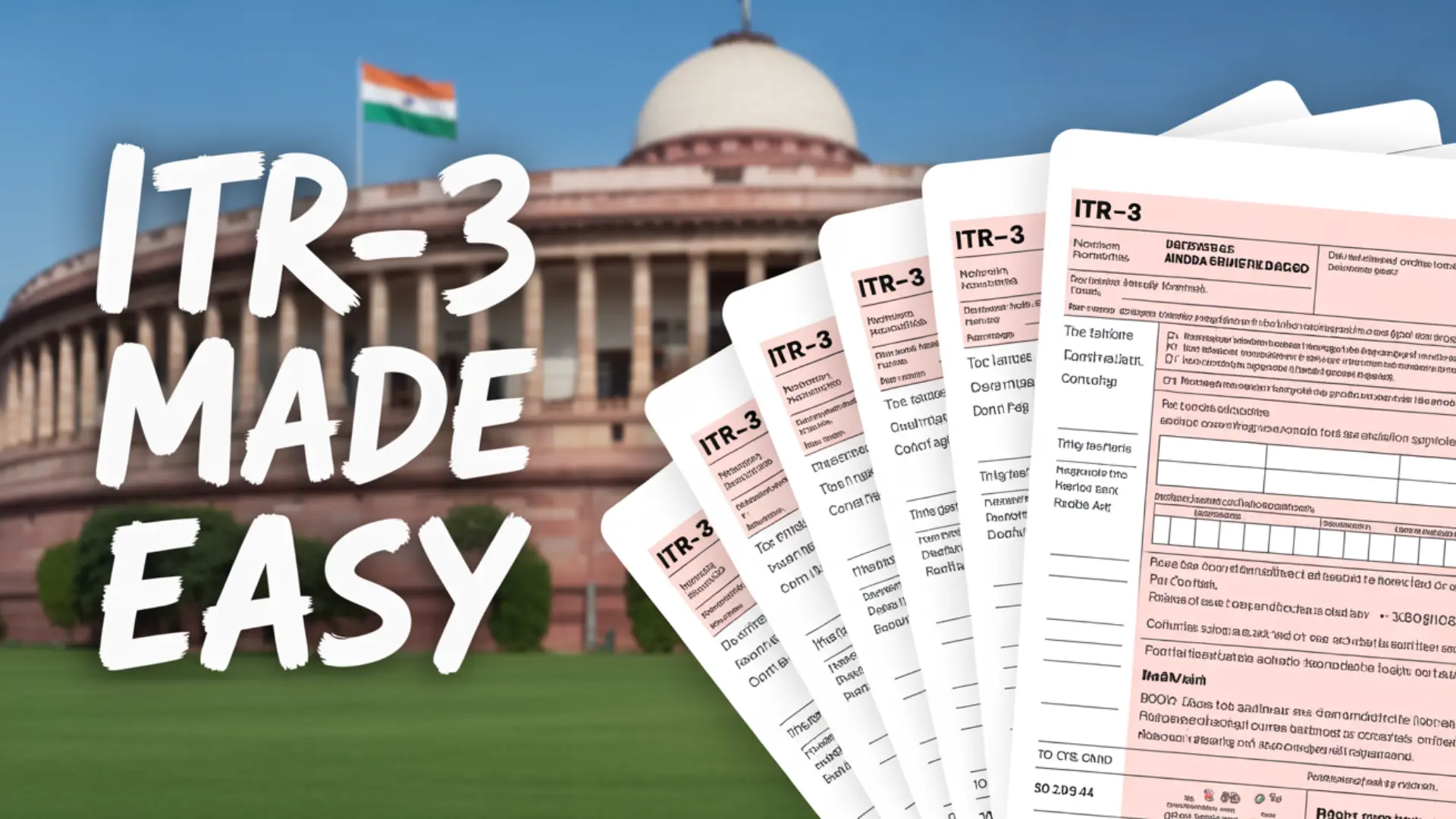FY 2024–25 • AY 2025–26
Table of Contents
- What is the ITR-3 Form?
- Who Can File ITR-3?
- How to File ITR-3 Online
- Key Sections in ITR-3
- Old vs New Tax Regime (FY 2024–25)
- Example: ₹15 Lakh Tax Calculation
- Common Mistakes to Avoid
- Tax Planning Tips for ITR-3 Filers
- Old vs New Regime: Quick Compare
- Benefits of Life Insurance
- FAQs on ITR-3
Filing income tax returns is a responsibility for every taxpayer in India. Among the different return forms, the ITR-3 form is specifically meant for individuals and Hindu Undivided Families (HUFs) who earn income from a business or profession. If you are a freelancer, consultant, trader, or a partner in a firm, understanding ITR-3 is essential for accurate tax filing.
What is the ITR-3 Form?
The ITR-3 form is designed for taxpayers who have income from the following heads:
- Business or profession (including freelancers and consultants)
- Salary or pension
- House property (rental income)
- Capital gains from investments, stock trading, or F&O
- Other sources, such as interest, dividends, or lottery winnings
Who Can File ITR-3?
- Business Owners: Proprietors, small traders, freelancers.
- Professionals: Doctors, lawyers, consultants, architects, designers, etc.
- Partners in Firms: Partners receiving income from partnership firms (if only exempt profit share—use ITR-2).
- Stock Market Investors & Traders: Capital gains, intraday, or F&O income.
- Multiple Income Sources: Business income plus salary, rental, or capital gains.
How to File ITR-3 Online
- Register/Login: Visit the e-filing portal and log in with PAN.
- Select Assessment Year: Choose AY 2025-26 for FY 2024-25.
- Choose the Form: Select ITR-3.
- Enter Details:
- Personal: PAN, Aadhaar, bank details, contact
- Income: salary, business/profession, capital gains, etc.
- Deductions: 80C, 80D, 80G and others
- Tax computation: payable/refundable
- Validate & Submit: Review, validate, and submit using DSC or Aadhaar OTP.
- Verify Return: E-verify (Aadhaar OTP/net banking/EVC) or send signed ITR-V.
Key Sections in ITR-3
- Part A: General Information
- Part B: Gross Total Income & Deductions
- Schedule BP: Business/Professional Income
- Schedule CG: Capital Gains
- Schedule OS: Income from Other Sources
- Schedule TTI: Tax Computation & Total Income
Old vs New Tax Regime (FY 2024–25 | AY 2025–26)
Old Tax Regime (with exemptions & deductions)
| Income Slab | Tax Rate |
|---|---|
| Up to ₹2.5 lakh | Nil |
| ₹2.5 lakh – ₹5 lakh | 5% |
| ₹5 lakh – ₹10 lakh | 20% |
| Above ₹10 lakh | 30% |
Health & Education Cess @ 4% plus surcharge, where applicable.
New Tax Regime (default; limited deductions)
| Income Slab | Tax Rate |
|---|---|
| Up to ₹3 lakh | Nil |
| ₹3 lakh – ₹6 lakh | 5% |
| ₹6 lakh – ₹9 lakh | 10% |
| ₹9 lakh – ₹12 lakh | 15% |
| ₹12 lakh – ₹15 lakh | 20% |
| Above ₹15 lakh | 30% |
Health & Education Cess @ 4% plus surcharge, where applicable.
Example: Tax Calculation for ₹15,00,000
Case 1: Old Regime (with deductions)
Assumptions: 80C = ₹1,50,000, 80D = ₹25,000, HRA benefit = ₹25,000
Total deductions = ₹2,00,000
Taxable Income = ₹13,00,000
- ₹0 – ₹2.5L → Nil
- ₹2.5 – ₹5L → ₹12,500
- ₹5 – ₹10L → ₹1,00,000
- ₹10 – ₹13L → ₹90,000
Total Tax = ₹2,02,500 + 4% cess = ₹2,10,600 (approx.)
Case 2: New Regime (no deductions)
Taxable Income = ₹15,00,000
- ₹0 – ₹3L → Nil
- ₹3 – ₹6L → ₹15,000
- ₹6 – ₹9L → ₹30,000
- ₹9 – ₹12L → ₹45,000
- ₹12 – ₹15L → ₹60,000
Total Tax = ₹1,50,000 + 4% cess = ₹1,56,000 (approx.)
Common Mistakes to Avoid
- Choosing the wrong form (e.g., ITR-2 instead of ITR-3)
- Missing capital gains or business/professional income
- Not comparing the Old vs the New tax regime before filing
- Forgetting to e-verify (return remains incomplete)
Tax Planning Tips for ITR-3 Filers
- Claim deductions: 80C (ELSS, PPF, LIC), 80D (health insurance), 80G (donations)
- Depreciation: On office equipment, vehicles, and machinery
- HRA & Home Loan: If you also have salary income
- Compare regimes: Use a calculator each year based on your deductions
Old vs New Regime: Quick Compare
| Feature | Old Tax Regime | New Tax Regime |
|---|---|---|
| Deductions & Exemptions | Allowed (80C, 80D, HRA, etc.) | Mostly Not Allowed |
| Rates | Higher | Lower |
| Best For | Taxpayers with high deductions | Taxpayers with fewer deductions |
Benefits of Life Insurance for ITR-3 Filers
- Tax Deduction: Premiums eligible under Section 80C
- Financial Security: Protects family income
- Retirement Planning: Aids in long-term savings
For the calculation Excel sheet, click here for access
Frequently Asked Questions (FAQs)
1) Who should file ITR-3?
Individuals and HUFs with income from business, profession, or partnership; also traders and investors with capital gains or F&O income.
2) Can salaried individuals file ITR-3?
Yes—if they also have business/professional income, capital gains, or trading income. Otherwise use ITR-1/ITR-2.
3) Is ITR-3 applicable for stock traders?
Yes. Intraday, derivatives (F&O), and capital gains reporting are supported in ITR-3.
4) ITR-3 vs ITR-4?
ITR-3 is for detailed reporting. ITR-4 is for presumptive taxation (44AD/44ADA/44AE).
5) Can I file ITR-3 online?
Yes, via the Income Tax e-Filing portal using PAN/Aadhaar login.
6) Common mistakes?
Wrong form selection, missing business/capital gains income, not choosing regime, and not e-verifying.
7) Due date?
Generally, 31 July for individuals; 31 October if audit is applicable (subject to government notifications).

